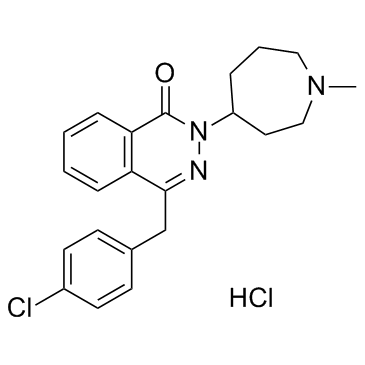

盐酸氮卓斯汀结构式

|
常用名 | 盐酸氮卓斯汀 | 英文名 | azelastine hydrochloride |
|---|---|---|---|---|
| CAS号 | 79307-93-0 | 分子量 | 418.359 | |
| 密度 | 1.25 g/cm3 | 沸点 | 533.9ºC at 760 mmHg | |
| 分子式 | C22H25Cl2N3O | 熔点 | 225-229ºC | |
| MSDS | 美版 | 闪点 | 276.7ºC | |
| 符号 |

GHS07 |
信号词 | Warning |
|
A qualitative method for prediction of amine oxidation in methanol and water.
J. Pharm. Sci. 104(4) , 1409-20, (2015) We have developed a predictive method, based on quantum chemical calculations, that qualitatively predicts N-oxidation by hydrogen peroxides in drug structures. The method uses linear correlations of two complementary approaches to estimate the activation bar... |
|
|
Design and characterization of chitosan-alginate microspheres for ocular delivery of azelastine.
Pharm. Dev. Technol. 19(7) , 813-23, (2014) The use of mucoadhesive biopolymers is one of the best approaches to prolong the drug residence inside the cul-de-sac, consequently increasing the bioavailability. Thus, the focus of this work was to develop mucoadhesive microspheres to overcome the limitatio... |
|
|
Adapalene inhibits the activity of cyclin-dependent kinase 2 in colorectal carcinoma.
Mol. Med. Report. 12 , 6501-8, (2015) Cyclin-dependent kinase 2 (CDK2) has been reported to be overexpressed in human colorectal cancer; it is responsible for the G1‑to‑S‑phase transition in the cell cycle and its deregulation is a hallmark of cancer. The present study was the first to use idock,... |
|
|
Antibiotics attenuate anti-scratching behavioral effect of ginsenoside Re in mice.
J. Ethnopharmacol. 142(1) , 105-112, (2012) The root of Panax ginseng CA Meyer (ginseng) has been used for diabetes, cancer, stress and allergic diseases in the traditional Chinese medicine.To understand the role of intestinal microflora in the pharmacological effect of ginsenoside Re, which is a main ... |
|
|
Effect of histamine H1 receptor antagonists on TARC/CCL17 and MDC/CCL22 production from CD14+ cells induced by antigenic stimulation in vitro.
Int. Arch. Allergy Immunol. 155(1) , 38-51, (2011) Thymus- and activation-regulated chemokine (TARC) and macrophage-derived chemokine (MDC) are accepted to be important molecules in the development and maintenance of allergic diseases. Although several types of histamine H(1) receptor antagonist (antihistamin... |
|
|
In vitro suppression of lymphocyte activation in patients with seasonal allergic rhinitis and pollen-related asthma by cetirizine or azelastine in combination with ginkgolide B or astaxanthin.
Acta Physiol. Hung. 99 , 173-184, (2012) Novel strategies are evaluated for management of allergic rhinitis and asthma in patients co-afflicted with both disorders. It is hypothesized that the platelet activating factor receptor antagonist ginkgolide B (GB) and the carotenoid antioxidant astaxanthin... |
|
|
Design and validation of a homogeneous time-resolved fluorescence cell-based assay targeting the ligand-gated ion channel 5-HT3A.
Anal. Biochem. 484 , 105-12, (2015) Ligand-gated ion channels (LGICs) are considered as attractive protein targets in the search for new therapeutic agents. Nowadays, this strategy involves the capability to screen large chemical libraries. We present a new Tag-lite ligand binding assay targeti... |
|
|
Δ-lactam derivative from thermophilic soil fungus exhibits in vitro anti-allergic activity.
Nat. Prod. Res. 26(23) , 2168-75, (2012) From cultures of thermophilic soil fungus Humicola grisea var thermoidea, a δ-lactam derivative (3-(2-(4-hydroxyphenyl)-2-oxoethyl)-5,6-dihydropyridin-2(1H)-one) that displayed anti-allergic activity was isolated, which was predicted by in silico computationa... |
|
|
The effect of topical corticosteroids, topical antihistamines, and preservatives on human ciliary beat frequency.
ORL J. Otorhinolaryngol. Relat. Spec. 76(3) , 127-36, (2014) The aim of this study was to investigate the effect of the corticosteroids, the antihistamines, and the preservatives benzalkonium chloride (BKC) and potassium sorbate (PS) in intranasal medications on human nasal epithelial ciliary beat frequency (CBF).Prima... |
|
|
Dermatitis induced by estrogen and progesterone: dual positive results on the intradermal skin test.
Dermatitis 22(6) , 354-7, (2011)
|